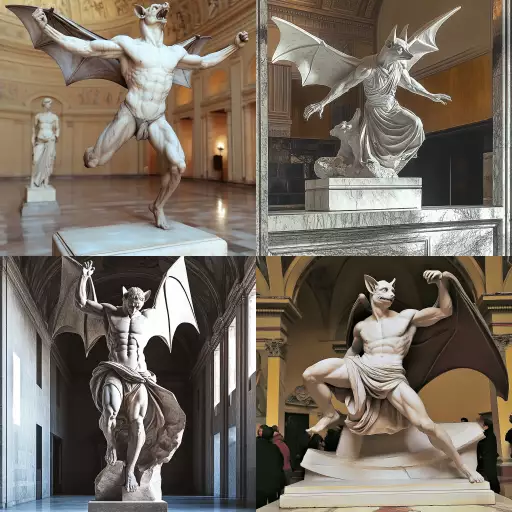Explore the Best AI Image Gallery

Beyond the Brush: How AI Image Generators are Reshaping the Creative Industry
The art world is experiencing a seismic shift, driven by the emergence of powerful AI image generation tools. These innovative technologies, capable of producing stunningly realistic and imaginative visuals from simple text prompts, are blurring the lines between human creativity and artificial intelligence. This revolution is not without its complexities, raising important ethical questions and prompting us to reconsider the very definition of art creation.
A New Era of Creative Possibilities
AI image generators offer a vast array of applications across diverse industries:
- Design and Marketing: Rapidly generate visuals for websites, social media, advertising campaigns, and product prototypes.
- Entertainment and Gaming: Create concept art, character designs, immersive environments, and dynamic in-game assets.
- Publishing and Education: Illustrate books, textbooks, and educational materials, bringing stories and concepts to life.
- Architecture and Urban Planning: Visualize architectural designs, cityscapes, and urban development projects.
- Art and Fashion: Explore new artistic expressions, generate unique fashion designs, and push the boundaries of creative imagination.
The Ethical Landscape: Copyright and Authenticity
As AI image generators become more sophisticated, ethical considerations take center stage. One of the most pressing concerns is copyright ownership. Who owns the rights to images generated by AI? Is it the user who provides the prompt, the developer of the AI algorithm, or the AI itself? Furthermore, questions arise about the authenticity and originality of AI-generated art. Can a machine truly be considered creative?
Navigating Bias and Representation
AI models are trained on vast datasets of existing images, which can inadvertently perpetuate societal biases and stereotypes. It is crucial to ensure that AI image generators do not reinforce harmful representations or discriminate against certain groups.
The Future of Creative Collaboration: A Human-AI Partnership
Rather than viewing AI as a threat to human creativity, it is essential to embrace its potential as a powerful tool for collaboration. Artists and designers can leverage AI to enhance their workflows, explore new creative avenues, and push the boundaries of artistic expression. The future of creativity lies in a harmonious partnership between human ingenuity and artificial intelligence.
Key Takeaways:
- AI image generators are revolutionizing the creative industry, offering unprecedented possibilities for design, art, entertainment, and more.
- Ethical considerations, including copyright, authenticity, bias, and representation, must be carefully addressed as AI technology evolves.
- The future of creativity lies in a collaborative partnership between human artists and AI tools, fostering innovation and pushing the boundaries of artistic expression.
](https://images.ai-img.art/thumbnails/150/9d51c5e673b4f2068b7b01abc35425a06f173b76303adf9ad29ca14302c25b18.webp)
























![**Representation: A dog acting as a private tutor to a child. The dog holds a ruler in its paw and stands at the blackboard to explain a dog diagram to the child. Graphic style: Line drawing, cartoon style, influenced by Franco-Belgian comics, thick black lines, simplified design, vector, black and white only, in the style of Keith Haring or the French comic strip "Alinéa". [IMPORTANT]: A single continuous line extending from one side of the image to the other, minimalist, strong outlines, line drawing, without lifting the hand, ultra-simplified, no shading, entirely white image, drawing created in the center of a sheet of paper. --ar 16:5** - <@627984126871470085> (fast)](https://images.ai-img.art/thumbnails/150/7a854648a81e51241dcca8d24dd6e3bfcf07ad1df51baf401c9b729f4cf411fa.webp)
![**Representation: A teenager smiling while thinking about a friendly dog, a comic-style thought bubble with a friendly dog inside. Graphic style: Line drawing, cartoon style, influenced by Franco-Belgian comics, thick black lines, simplified design, vector, black and white only, in the style of Keith Haring or the French comic strip "Alinéa". [IMPORTANT]: A single continuous line extending from one side of the image to the other, minimalist, strong outlines, line drawing, without lifting the hand, ultra-simplified, no shading, entirely white image, drawing created in the center of a sheet of paper. --ar 16:5** - <@627984126871470085> (fast)](https://images.ai-img.art/thumbnails/150/6fc850f638e3dee0c4b121acecad2c8419e02bdeac7f871d625f1003c1c3abe1.webp)












](https://images.ai-img.art/thumbnails/150/157712d76865d557120f9baf988de3d0525225295a2789c89bf2c4a5a96a03d1.webp)


![**Representation: A dog acting as a private tutor to a child. The dog holds a ruler in its paw and stands at the blackboard to explain a dog diagram to the child. Graphic style: Line drawing, cartoon style, influenced by Franco-Belgian comics, thick black lines, simplified design, vector, black and white only, in the style of Keith Haring or the French comic strip "Alinéa". [IMPORTANT]: A single continuous line extending from one side of the image to the other, minimalist, strong outlines, line drawing, without lifting the hand, ultra-simplified, no shading, entirely white image, drawing created in the center of a sheet of paper. --ar 16:5** - Variations (Strong) by <@627984126871470085> (fast)](https://images.ai-img.art/thumbnails/150/f4e034998ccd869d8a061fd12017514fcd92210eb33d4222dc9b54716223f4dd.webp)
](https://images.ai-img.art/thumbnails/150/51c93500396faff4e7fa8b42bc68033067b16b2230e3496e95c482a581ff0fe9.webp)
